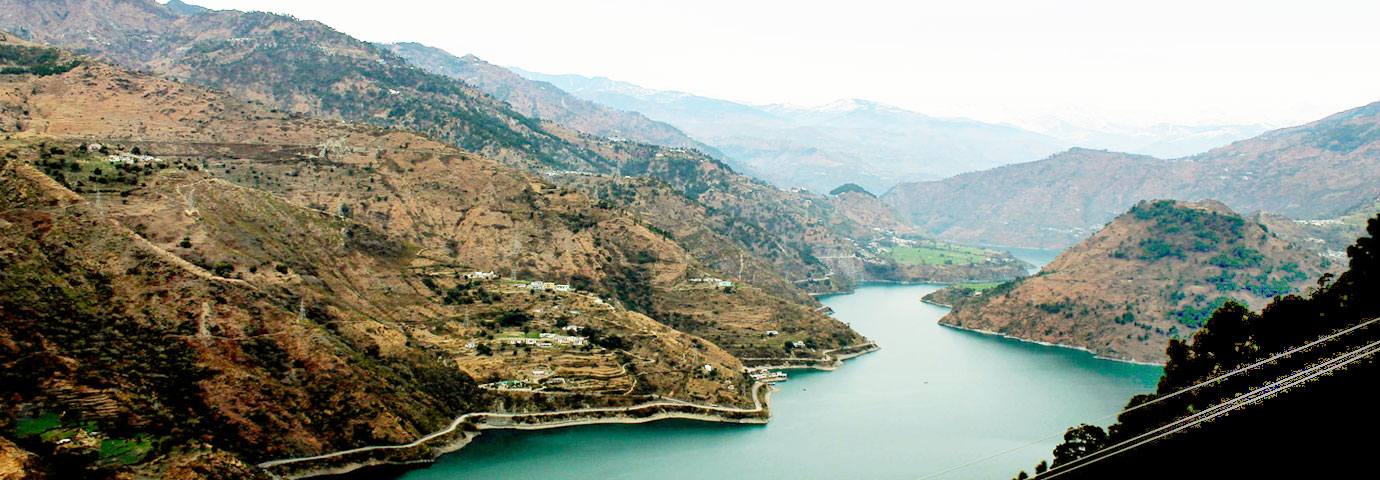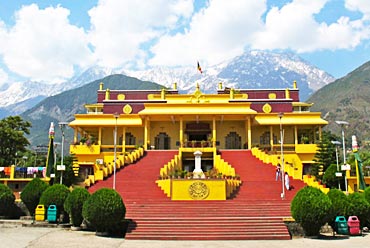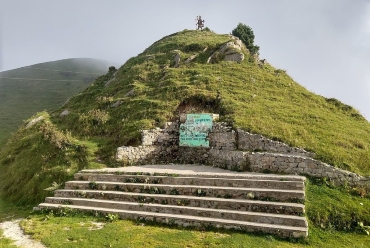Fast Facts
|
Language |
Hindi, Himachali, English |
|
Best time to visit |
November-February |
Dalhousie a tourist place in India attracts numerous visitors every year. Compared to other hill stations, Dalhousie, 80 winding kilometers from Pathankot, is markedly different and off the beaten track. Spread over five hills, Dalhousie has a serenity with its own distinctive flavor. Attractive cottages and villas cling to the deodar and pine mantled hills of Dalhousie. Here at Dalhousie, nothing seems to matter except the beauty and the moment. All this and more make Dalhousie a tourist place in India. Pink and red rhododendrons are in bloom. The trees are dressed in different shades of green. There is no swirl of traffic. The shops are small and trim. Whistling softly to himself, a shopkeeper arranges embroidered Chamba shawls in his showcase. Tourists appraise Chamba chappals embroidered with gold thread, cane baskets, colorful woolens, and life-like Chamba dolls - all specialties of the region. Piles of walnuts and red, black and green Chamba chilies adorn many shop fronts. We pass children joyfully picking strawberries from a hillside decorated with alpine flowers. There are several good hotels in Dalhousie like Hotel Spring Dalhousie that ensure a comfortable stay.
Location Of Dalhousie
Dalhousie a tourist place on India is ideally located. Lined against the railings, several people admire the exquisite views that are a special feature of Dalhousie. The clouds come skimming down and dally amongst the mountains for a moment. The next moment, they begin playing hide and seek with the Dhauladhars, changing the shape of the skyline with astonishing rapidity. Soaring up to 21,000 feet, the Dhauladhars themselves are constantly changing color - smoky blue, gray green, orchid blue, violet. On the nearer hill slopes, every tree stands distinct and green and lordly. In the valley below, the rice fields glint in the sunshine. Most of the hotels in Dalhousie like Hotel Spring Dalhousie are ideally located close to the tourist spots.
History Of Dalhousie
Today, Dalhousie is a tourist place in India even earlier it had attracted the British. In 1851, the princely state of Chamba was approached by Lord Napier of Magdala. The British wished to establish a sanatorium for Europeans on the outer slopes of the Dhauladhar range. There, the sun shone warmly on scented forests of pine and oak, the air was crisp and invigorating, the scenery beautiful. Negotiations were carried on with the Raja of Chamba and in 1853, the plateau of Kathlog, Portreyn, Tehra and Bakrota were transferred to the Government of India against a compensation of Rs. 2000 to be paid as an annual tribute to Chamba state. On the recommendation of Sir Donald McLeod, the new sanatorium was named Dalhousie, after Lord Dalhousie, the first British Governor General of India. In 1866, the cantonment area of Balun was also taken over and remains a cantonment to this day.
Tourist Attractions in Dalhousie
Though spread over five distinct hills - Kathlog, Portreyn, Tehra, Bakrota and Balun, covering an area of 13 sq km - the main center continues to be at Portreyn. The Figure of Eight of Portreyn is the most popular walk in Dalhousie. Starting from the Portreyn Mall, it crosses the meeting places of Subhash Chowk and Gandhi Chowk. Along the rocks on the way, Tibetans have carved colorful pictures in relief.
One of the best views of the glorious surroundings of Dalhousie can be obtained from Kalatope, 8 km from the center of Dalhousie. At Panchpulla (Five Bridges) - a good spot for picnics - can, if one is lucky to run into an old Dalhousie resident, be heard interesting snippets that intertwine India's freedom struggle with Dalhousie. Satdhara has long been known for its mineral water which was once shipped to England on a regular basis. Dalhousie also has Dainkund - the Singing Hill. The passage of mountain winds through the forest at Dainkund produces a series of effects - depending on the wind's velocity - ranging from a gentle humming to an eerie wail.
Places Around Dalhousie
Khajjiar
Around Dalhousie are wealth of places which beckon those who have an eye for beauty or a nose for adventure. Khajjiar, just 7 kilometers from Dalhousie is an enchanting saucer shaped meadow fringed by cedar trees of great antiquity and stateliness. In the center of the grassy meadow at Khajjiar lies a small lake. And on it, are two floating islands, sometimes hidden from view by the tall grass that grows on them. Khajjiar, known as one of the "most charming spots in the Himalayas", derives its name it is said from its ancient, golden domed temple of Khajinag. A nine hole golf course is an added attraction at Khajjiar.
Chamba
Beyond Khajjiar, a fascinating two hour (56 km) drive from Dalhousie, perched on a ledge overlooking the Ravi river and soaring skywards in a series of tiers, stands the historic temple town of Chamba. Often described as "a jewel of the Himalayas", Chamba, 920 metres above sea level, steeped in legends and guarded by rich forests, is named after a beautiful princess - Champavati. Some say that Chamba was so named because of the abundance of fragrant Champa flowers in the area.
Three temples in the Lakshminarayana temple complex are dedicated to Shiva and three to Vishnu. The image of Vishnu-in white marble adorned with gold-is outstanding. The oldest of Chamba's many temples, distinguished by rich carvings on both the exteriors and the interiors, dates to the 7th century A.D. Along with its ancient temples which represent the "most noble specimens of Hindu architecture", the palaces of the Raja are striking. The Rang Mahal or Painted palace, with towers on either side, resembles a feudal castle. Inside, painted in colors that have retained their brightness despite the passage of time, are a variety of exquisite murals, some depicting episodes from age old Indian epics. These precious works of art have now been distributed to Himachal State Museum at Shimla, the National Museum at Delhi while some remain at the Bhuri Singh Museum in Chamba.
The Bhuri Singh Museum named after the ruling prince-the last Raja of Chamba-who established it in 1908 on the advice of the eminent scholar-historian, Dr. Vogel-contains priceless treasures of art. Carved woodwork from Brahmaur-home of the Gaddis (shepherds) and the capital of the area before Chamba was built, Kangra, Basholi and Chamba paintings, sculptures, stone inscriptions, wonderful embroideries, ancient weapons, and other rare artifacts can be seen at the Bhuri Singh Museum.
The stone and wood slate roofed houses of Chamba works of art in themselves reflect the rich artistic heritage of the area. Balconies, doors, windows, brackets are often beautifully carved in a range of designs and figures flowers, birds, Gods and Goddesses. Within the works of art that are their homes, Chamba women excel in creating Chamba rumals (large handkerchiefs). Exquisite examples of needle painting, the rumals of Chamba have long been famous-for their unusual beauty, and as symbols and omens of goodwill. Weddings in the hills and valleys around Chamba are still not complete without an exchange of Chamba rumals. The highly distinctive Chamba rumals have gone through an interesting period of evolution. In addition to its rumals, Chamba is also known for the design and quality of its leather chappals (flat, open shoes) and belts. Like the rumals, Chamba chappals with their open toes and partially woven 'vamps' catch even the most unobservant eye and are very light and comfortable.
On two occasions every year, Chamba comes a scene of solemnity followed by revelry. Centuries ago, when Chamba was built, it faced a major problem of water supply. Even though a channel was carved from a neighboring stream, the water refused to enter the new township. To propitiate the spirit of the stream, the Rani, on the advise of Brahmins allowed herself to be buried alive at the meeting point of the proposed water course and the stream. Water began to flow into Chamba the moment the Rani's grave was filled and ever since then, it is said, Chamba has had an adequate water supply. A temple was erected in honor of the Rani who sacrificed herself and every year a fair called the Suhi Mela, traditionally attended only by women and children, is held near the Rani's shrine in spring. The festival of Minjar is held every autumn.
From Chamba, you will need to descend into the Kangra valley with its mellow beauty to reach Palampur, a charming hill station which is so much off the beaten track that not many people have heard of it.
Palampur
A picture of sylvan elegance, Palampur, nestling at 1269 meters in the magnificent shadow of the White Mountains-the mighty snow covered Dhauladhars-is also called Himachal's Valley of Flowers. Avenues shaded by pines and cedars, hedges with wild rambling roses in red and white and pink, flowering wisterias, fragrant gardenias, sprawling tea gardens where smiling hill women deftly pick tea leaves, gurgling brooks, green gold fields of rice swaying in the wind, and stylish bungalows impart a refreshing character to Palampur, lying in the near the point where the Dhauladhars rise sheer from the Palam valley.
The Khad is an awesome chasm strewn with white boulders, and on the slopes around Palampur can be seen quaint Gaddi hamlets with their slate roofed homesteads and carved doors and windows. A trek to any one of the many hill villages around Palampur is rewarding. Water mills can be seen in action, as the can the kilns where small tea growers dry their tea leaves. Close by is Andretta -once the home of Sobha Singh, the great painter and artist, and of Mrs. Norah Richards, who, influenced by Walt Whitman's "Leaves of Grass", settled at Andretta to carry out her experiment in the art of simple living and solitude.
Take the road that gently winds its way uphill from Palampur, and after less than an hour's driving, you'll arrive at Baijnath-the abode of the Lord of Physicians.
Baijnath
Set like a jewel against the splendid backdrop of the legendary Dhauladhars, the spired temple of Baijnath-the abode of the Lord of Physicians-continues to attract people from all corners of India, and the world. Built by two merchant brothers-Manyuka and Ahuka-more than a thousand years ago, in 804 A.D., the temple of Baijnath has acquired an aura of mystic invincibility. Inside, the 'lingam' of Vaidyanatha Lord Shiva has long been a symbol of veneration for the vast numbers who journey to this temple year after year. The temple priests claim a lineage as old as the temple. Month after month, they have observed the motley crowd of people who become unified by the sheer strength of faith as they approach the 'lingam'. Many travel to Baijnath in the hope that the Lord of Physicians will grant a boon and free them of ailments. The water at Baijnath is reputed to possess remarkable digestive properties and it is said that till the recent past, rulers in Kangra Valley would drink only water obtained from Baijnath.
Bir And Billing
Above Baijnath, touching the foot of the mighty Dhauladhars, is the ancient, picturesque village of Bir. Once the seat of the powerful Pal Rajputs, Bir is now the venue of an annual fair, traditionally a part of the Holi Festival. The beautiful oak forest of Bir resounds with the joyous sound of dancing and singing and carefree laughter, as Gaddis and Kanets pour in from the mountains around. They bring with them their Gods dressed in all their finery, ceremoniously placed and carried in colorful palanquins. Worship is an important part of the festivities during which huge quantities of lugri (rice beer) are consumed.
14 km from Bir lies Billing-the venue of an annual hang gliding tournament and reputedly one of the finest sites for hang gliding in the world. From Billing, one has to return to Bir, Baijnath, and pass once again through Palampur to reach Dharamshala the Abode of the Dalai Lama, just 40 km from Palampur.
Triund
The most interesting, the most spectacular trek from McLeod Ganj is the 12 km climb to Triund-a level clearing atop a spur-an exciting 2827 meters above sea level. Massive rocks, exotic mountain plants and ice covered ponds hold one's attention for a while. Below, you can see the Pong Dam in the hazy distance. Above Triund, the Dhualadhars rise in icy splendor. From the Forest Bungalow at Triund, glorious treks of discovery can be made treks that reveal the Dhauladhars in all their many colors and moods. The crisp air, the pristine beauty and mountain splendors of Triund are a fitting finale to a journey through the hill stations of Himachal Pradesh.
Dharamsala
The sleepy town of Dharamsala overlooking the Kangra Valley was irrevocably changed when the Dalai Lama claimed it as his residence-in exile in 1959. Although the Tibetan influence is what has made the town famous, the colorful combination of cultures in this mountainside town is what makes it fascinating. Brilliantly smiling Tibetan refugees; a tribe of cholu clad nomadic shepherds known as gaddis and reputed to be descendants of Alexander the great; Hindus from all walks of life; chanting Buddhist monks in unsewn wine colored robes; and a fresh crop of international hippies make up the 17,000 people who inhabit this hill station.
Divided into Upper and Lower Dharamsala, the city is shadowed by the snow capped 5200 meter high Dhauladhar mountains. Centered in the middle of this division, the winding road out of Lower Dharamsala stops at Clouds End Villa. Once serving as the summer home of the Raja of Lambagraon and Kangra, it is now a gracious hotel run by the titled couple. Aptly named, it is here that all memory of a dusty, overnight train ride finally fades as the hospitality of the charming proprietors, Raja Aditya and Chandresh Katoch and the majestic scenery take over.
Dating back to the Vedic period, the remains of the Kangra Fort, once part of the great Katoch kingdom, sits dramatically atop a precipice overlooking the confluence of the Bangangat and Majhi rivers, 17 km from Dharamsala. Here one can watch the sun set while the parrots played tag among the bare limbed trees clinging to the steep cliffs and the maharaja kept us spellbound with stories of his ancestors exploits. The fort is today run by the Archaeological Survey of India.
Upper Dharmsala/Mcleodganj
History is not the only reason to visit Dharamsala; the present day sites beckon the tourist. Each morning, awakened by the steady chant of the same pacing monk, one can climb the mountain pass which originates at Cloud's End. At a height of 1800 metres, our goal was the Tibetan refugee town of McLeod Ganj. It was here that the Dalai Lama resettled after escaping the Chinese invasion of Tibet.
Restaurants and hotels run by his followers abound. In the center of town, the colorful prayer wheel outside the Namgyalma Stupa is never still as passing worshippers run their hands over the revolving poles in deliverance of their prayers. Hours can be spent wandering among the small, closely gathered stores run by striped-aproned Tibetan women selling handicrafts, jewelery and Tibetan clothing. Down the hill lies the complex housing the Dalai Lama's Residence, the Namgyal Monastery and the Central Cathedral. As we watched their hands loudly gesturing in an unmistakable sign of disagreement, the silent monks heatedly debated Buddhist philosophy. The cathedral and debating courtyard are open to the public. It is also possible, when requested one month in advance, to arrange an audience with the Dalai Lama. Further examples of Tibetan culture can be found in the School and Library of Tibetan Studies, the Tibetan Children's Village School and the Tibetan Institute of Performing Arts, all located within a short distance of McLeod Ganj.
The area is also important to the Hindu religion. Bhagsunath, the site of a Hindu temple, is a two kilometer walk from McLeod Ganj. Its waterfall also makes it a popular picnic spot. Neither has McLeod Ganj been missed by the present day hippies who have found tranquility among the many ashrams to be found in Dharamsala.
Lower Dharamsala
Down the steep path towards Lower Dharamsala is the Church of St. John in the Wilderness. This building with its Belgium stained glass windows and monument to Lord Elgin is a reminder of the days of the British Raj. Lower Dharamsala is the more crowded and less picturesque section. It houses the Museum of the Kangra School for Miniature Paintings which Raja Sansar Chanda helped develop.
How To Reach
By Rail- The nearest railhead is Pathankot, 80 kilometers downhill. We would provide you all India tourist permit vehicles for the local transportations and also for the intercity drives too.
Best Time to Visit
Dalhousie is a year-round destination but the best time to visit Dalhousie is from November to March. This time you can enjoy the stunning views of snow-clad Dhauladhar Mountain peaks.




